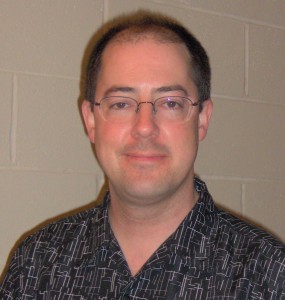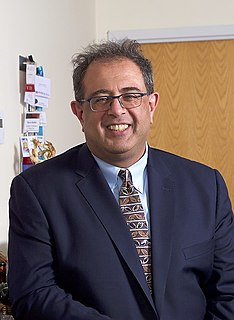Related Research Articles

Microelectromechanical systems (MEMS), also written as micro-electro-mechanical systems and the related micromechatronics and microsystems constitute the technology of microscopic devices, particularly those with moving parts. They merge at the nanoscale into nanoelectromechanical systems (NEMS) and nanotechnology. MEMS are also referred to as micromachines in Japan and microsystem technology (MST) in Europe.
Microtechnology deals with technology whose features have dimensions of the order of one micrometre. It focuses on physical and chemical processes as well as the production or manipulation of structures with one-micrometre magnitude.
Microfabrication is the process of fabricating miniature structures of micrometre scales and smaller. Historically, the earliest microfabrication processes were used for integrated circuit fabrication, also known as "semiconductor manufacturing" or "semiconductor device fabrication". In the last two decades microelectromechanical systems (MEMS), microsystems, micromachines and their subfields, microfluidics/lab-on-a-chip, optical MEMS, RF MEMS, PowerMEMS, BioMEMS and their extension into nanoscale have re-used, adapted or extended microfabrication methods. Flat-panel displays and solar cells are also using similar techniques.
Engineering science and mechanics (ESM) is a multidisciplinary and interdisciplinary engineering program and/or academic department. It is available at various American universities, including Pennsylvania State University, University of Virginia, Virginia Polytechnic Institute and State University, Georgia Institute of Technology, and University of Alabama.

Kristofer S. J. Pister is a professor of electrical engineering and computer sciences at University of California, Berkeley and the founder and CTO of Dust Networks. He is known for his academic work on Microelectromechanical systems (MEMS), their simulation, his work on Smartdust, and his membership in the JASON Defense Advisory Group. He is the son of former Berkeley Dean of Engineering and former UC Chancellor Karl Pister.

Mike A. Horton is an American engineer and founder of a company producing sensor technology and sensor-based systems.

Sangeeta N. Bhatia, M.D., Ph.D. is an American biological engineer and the John J. and Dorothy Wilson Professor at MIT’s Institute for Medical Engineering and Science and Electrical Engineering and Computer Science (EECS) at the Massachusetts Institute of Technology (MIT) in Cambridge, Massachusetts, United States. Bhatia's research investigates applications of micro- and nano-technology for tissue repair and regeneration. She applies ideas from computer technology and engineering to the design of miniaturized biomedical tools for the study and treatment of diseases, in particular liver disease, hepatitis, malaria and cancer.
MEMS for in situ mechanical characterization refers to microelectromechanical systems (MEMS) used to measure the mechanical properties of nanoscale specimens such as nanowires, nanorods, whiskers, nanotubes and thin films. They distinguish themselves from other methods of nanomechanical testing because the sensing and actuation mechanisms are embedded and/or co-fabricated in the microsystem, providing—in the majority of cases—greater sensitivity and precision.
Microelectromechanical system oscillators Devices that generate highly stable reference frequencies to measure time. The core technologies used in MEMS oscillators have been in development since the mid-1960s, but have only been sufficiently advanced for commercial applications since 2006. MEMS oscillators incorporate MEMS resonators, which are microelectromechanical structures that define stable frequencies. MEMS clock generators are MEMS timing devices with multiple outputs for systems that need more than a single reference frequency. MEMS oscillators are a valid alternative to older, more established quartz crystal oscillators, offering better resilience against vibration and mechanical shock, and reliability with respect to temperature variation.
Shuvo Roy is an Bangladeshi-American scientist and engineer.

Nam-Trung Nguyen is a Vietnamese-Australian researcher in the fields of Microfluidics and Nanofluidics. He is notable for his work on nerve agent detector, PCR, Micromixer, Droplet-based Microfluidics, Micro Magnetofluidics, Liquid Marbles and Micro Elastofluidics. He is currently a Professor and Director of Queensland Micro and Nanotechnology Centre at Griffith University. He was a former Associate Professor at Nanyang Technological University, Singapore. Nguyen is a Fellow of ASME and a Senior Member of IEEE.

Kurt E. Petersen is an American inventor and entrepreneur. He is known primarily for his work on microelectromechanical systems. Petersen was elected a member of the United States National Academy of Engineering in 2001.
Gabriel Alfonso Rincón-Mora is a Venezuelan-American/Hispanic-American electrical engineer, scientist, professor, inventor, and author who was elected a fellow of the American National Academy of Inventors (NAI) in 2017, Institute of Electrical and Electronics Engineers (IEEE) in 2011, and Institution of Engineering and Technology (IET) in 2009 for contributions to energy-harvesting and power-supply integrated circuits (ICs). Rincón-Mora is the Motorola Solutions Foundation Professor at the Georgia Institute of Technology, where he's been Assistant/Associate/Full Professor since 2001.

Roger Thomas Howe is the William E. Ayer Professor of Electrical Engineering at Stanford University. He earned a B.S. degree in physics from Harvey Mudd College and M.S. and Ph.D. degrees in electrical engineering from the University of California, Berkeley in 1981 and 1984, respectively. He was a faculty member at Carnegie-Mellon University in 1984-1985, at the Massachusetts Institute of Technology from 1985-1987, and at UC Berkeley between 1987-2005, where he was the Robert S. Pepper Distinguished Professor. He has been a member of the faculty of the School of Engineering at Stanford since 2005.

Reza Ghodssi is a Professor in the Department of Electrical and Computer Engineering and the Institute for Systems Research (ISR) at the University of Maryland, College Park, where he directs the MEMS Sensors and Actuators Lab and holds the Herbert Rabin Distinguished Chair in Engineering. Ghodssi is also the Inaugural Executive Director of Research and Innovation for the A. James Clark School of Engineering at the University System of Maryland at Southern Maryland (USMSM). He is best known for his work designing micro- and nano-devices for healthcare applications, particularly for systems requiring small-scale energy conversion and biological and chemical sensing.
Srinivas Tadigadapa is a professor and chair of the Department of Electrical and Computer Engineering at Northeastern University in Boston, Massachusetts. From 2000 to 2017 he was a professor of electrical engineering at Penn State University. Prior to that, he was the vice president of manufacturing at Integrated Sensing Systems Inc., and was involved with the design, fabrication, packaging, reliability, and manufacturing of micromachined silicon pressure and Coriolis flow sensors.
John X. J. Zhang is a professor at Thayer School of Engineering of Dartmouth College, and an investigator in the Dartmouth-Hitchcock Medical Center. Before joining Dartmouth, he was an associate professor with tenure in the Department of Biomedical Engineering at the University of Texas of Austin. He received his Ph.D. in electrical engineering from Stanford University, California in 2004, and was a research scientist in systems biology at the Massachusetts Institute of Technology (MIT) before joining the faculty at UT Austin in 2005. Zhang is a Fellow of the American Institute for Medical and Biological Engineering (AIMBE), and a recipient of the 2016 NIH Director's Transformative Research Award.

Niels Quack is a Swiss and German engineer specialized in optical micro engineering. He is a SNSF professor at EPFL and director of the Photonic Micro- and Nanosystems Laboratory at its School of Engineering.

Ha Duong Ngo is an academician, research scholar in the field of Electrical Engineering/Microsystems Engineering.
Pritiraj Mohanty is a physicist and entrepreneur. He is a professor of physics at Boston University. He is most known for his work on quantum coherence, mesoscopic physics, nanomechanical systems, and nanotechnology with a recent focus on biosensing and nanomechanical computing.